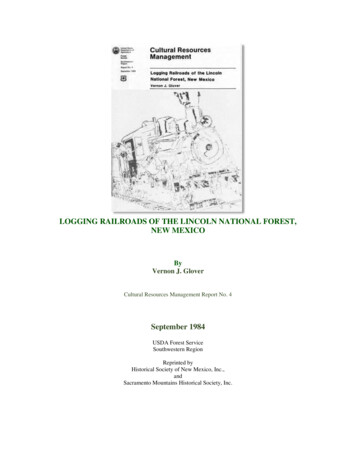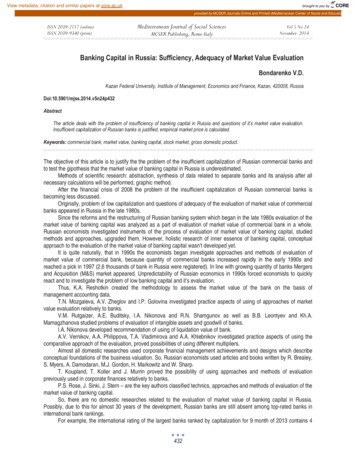
Transcription
Country Analysis Executive Summary: RussiaLast Updated: December 13, 2021Overview Russia was the world’s third-largest producer of petroleum and other liquids (after the UnitedStates and Saudi Arabia) in 2020; it had an annual average of 10.5 million barrels per day (b/d) intotal liquid fuels production. Russia was the second-largest producer of dry natural gas in 2020(second to the United States), producing an estimated 22.5 trillion cubic feet (Tcf).Europe is Russia’s main market for its oil and natural gas exports, and by extension, Europe is itsmain source for revenues. Russia is a major source of oil and natural gas for Europe; a significantshare of Europe’s oil and natural gas imports come from Russia.Since 2014, Russia has been subject to sanctions imposed by the United States and theEuropean Union (EU). The sanctions were imposed in response to the actions and policies of theRussian government with respect to Ukraine. The U.S. sanctions mainly affect Russian energycompanies’ access to U.S. capital markets and to goods, services, and technology in support ofdeepwater exploration and field development.Since April 2020, Russia has been actively coordinating oil production with a number of OPECand other non-OPEC producers, collectively known as the OPEC agreement. The OPEC agreement aimed to curb crude oil production in response to rapidly declining demand resultingfrom the COVID-19 pandemic. 1On July 18, 2021, OPEC agreed to begin increasing production quotas for the participatingcountries and to extend the duration of the OPEC agreement through the end of 2022. Thedeal followed an impasse in negotiations a few weeks earlier when the representative of theUnited Arab Emirates (UAE) demanded a revision to its crude oil production baseline, which isused to calculate countries’ respective production quotas. The July 2021 deal resulted in anincrease in Russia’s production baseline from 11.0 million b/d to 11.5 million b/d starting in May2022 and also allowed Russia’s production quota to increase by 100,000 b/d per monthbeginning in August 2021. 2Petroleum and Other LiquidsSector organization Domestic companies dominate most of Russia’s oil production. Approximately 81% of Russia’stotal crude oil production in 2020 came from Russian firms Rosneft, Lukoil, Surgutneftegas,Gazprom, and Tatneft. 3In October 2020, the Russian government approved changes to the hydrocarbon sector’s taxregime that eliminated tax exemptions for oil and natural gas companies operating in extra1
viscous or heavily depleted fields (primarily oil sands and mature fields). The elimination of taxexemptions, particularly for extra-viscous fields, pose a challenge for oil sand operators becausethe tax changes significantly increase the tax burden and may lead to oil sands productionbecoming uneconomical. 4 Additional changes include:— The phase-out of export duties on crude oil and refined products— The phase-out of the Tax on Additional Income that was introduced in 2019 and aimedto calculate taxes based on profits accrued by hydrocarbon companies— An annual incremental increase on the minerals extraction tax (MET), which would ineffect shift the tax base away from exports toward upstream production— Tax breaks and fiscal incentives for companies seeking to develop new fields in easternArctic regions.The amendments to the tax regime were made to increase government revenue and favorcompanies operating in the Arctic region, where development has been limited because ofsanctions as well as the technical complexity of extracting hydrocarbons from the reservoirs,factors that had made Arctic upstream development uneconomical. The tax breaks andincentives for Arctic upstream development aim to bring more projects online without the needfor partnerships with Western international oil companies (IOC). International sanctions havemade participating in Russian upstream development difficult for IOCs. 5In June 2020, the Russian government approved its Energy Strategy to 2035, which seeks todiversify energy exports, modernize the country’s energy infrastructure, increase nationalcompetitiveness, and develop greater technological innovation and digitalization within itsenergy system. 6 The Energy Strategy to 2035 prioritizes the increase in energy exports andrevenue and the expansion of natural gas infrastructure, particularly midstream in easternSiberia and the far eastern regions, to ensure the resilience of the country’s energy system. Theprioritization of exports and revenue is indicative of the central role hydrocarbons play for theRussian government. Crude oil and natural gas revenue comprised approximately 43%, onaverage, of the government’s total annual revenue between 2011 and 2020. 7 This includesexport and tax revenue that the government collected from oil and gas production and sales.Exploration and production Russia’s proved oil reserves were 80 billion barrels as of January 2021, according to the Oil &Gas Journal. 8In 2020, Russia’s production of petroleum and other liquid fuels was 10.5 million b/d (of which9.9 million b/d was crude oil including lease condensate). Russian economy consumed about 3.4million b/d (Figure 1).A number of greenfield projects in Russia have been under development in the past few yearsthat will provide a boost to Russia’s crude oil production in the short term when the projectscome online and reach their peak production levels. (Table 1) However, declining output fromRussia’s more mature fields (primarily in Western Siberia, Russia’s largest oil producing region)may offset the production growth coming from greenfield development, which may result inRussia’s crude oil production declining by the end of the 2020s decade. In addition to greenfielddevelopment, companies are increasing drilling at some existing mature oil fields and are tyingin smaller fields to existing infrastructure at larger fields to help increase recovery rates andmitigate some of the production decline. However, brownfield development efforts in Russia areunlikely to reverse the decline in production in the longer term. 9In 2020, Rosneft created Vostok Oil LLC, a special purpose entity, to develop a group of crude oiland natural gas fields collectively known as the Vostok Oil project in the northern part of the2
Krasnoyarsk region. The Vostok oil project seeks to tie in fields in the Vankor cluster (whichconsists of the Vankorskoye, Tagulskoye, Suzunskoye, and Lodochnoye fields and is currentlyproducing about 300,000 b/d) as well as some existing discoveries in the Taymyr peninsula.Collectively, these fields could potentially produce about 1 million b/d to 2 million b/d at peakproduction, according to Vostok Oil. Moreover, much of the infrastructure required to fullydevelop the project into an industrial hub still needs to be built. Vostok Oil aims to have theproject come online in 2024, reach an initial production level of 600,000 b/d, and reach itsplateau production level by 2030. 103
Table 1. Selected crude oil greenfield projects in RussiaPeakproductionyear,estimatePeak production(barrels per day),estimateProject nameFieldOperatorStart 20172023116,000Vostok Oil azRusskoye Phase koye phase rtovskoye phase hantosAlexander ZhagrinGazpromneft2019202381,000Source: Table by the U.S. Energy Information Administration, based on data from the Rystad Energy, Rosneft, and Gazpromcompany websitesNote: Peak production estimates are for crude oil and condensate production only and does not include production volumesfrom associated natural gas.Transport and storagePipelines In March 2020, state-owned Transneft reached a settlement with TotalEnergies over thecontaminated crude oil and condensate that led to the shutdown of the Druzhba pipeline inApril 2019. The Druzhba crude oil and condensate pipeline was shut down after importers foundthe crude oil to be contaminated with high levels of organic chlorides, disrupting Russia’s crudeoil and condensate exports to Germany, Poland, and Belarus and to a lesser extent, CzechRepublic, Slovakia, and Hungary. It also affected exports out of Russia’s Baltic Sea port of UstLuga. 11The Caspian pipeline transports crude oil to Novorossiysk, Russia, from the Tengiz, Kashagan,and Karachaganak fields in Kazakhstan as well as Russian fields in the Caspian region. TheCaspian Pipeline Consortium (CPC), the legal entity that owns and operates the Caspian pipeline,is implementing a de-bottlenecking program, which aims to increase throughput of its oilpipeline network from 1.3 million b/d to 1.6 million b/d. The program will increase throughputnot by building additional pipeline infrastructure, but by replacing midstream equipment andbuilding new storage tanks and a pump station that would enable it to better optimize thecurrent capacities and throughput of the pipeline network. CPC expects to complete theprogram by the end of 2023. 12Port terminals Russia’s four largest ports (Primorsk, Nakhodka, Novorossiysk, and Ust-Luga) for crude oilexports together accounted for 71% of Russia’s seaborne crude oil liftings in 2020 (Table 2). 134
Table 2. Russia's seaborne crude oil exports by port terminal,2020thousand barrels per dayPort terminalCrude oil ga437Murmansk271Sokol Sakhalin265Varandey221Others127Source: Table by the U.S. Energy Information Administration, based on data fromClipperdataRefining and refined oil products According to Oil & Gas Journal, as of January 2021, Russia had 5.5 million b/d of crude oilrefining capacity from more than 25 refineries. Rosneft, the largest refinery operator, ownsmore than 2 million b/d of crude oil refining capacity. 14Gazprom Neft is currently upgrading its refinery at Omsk, located in Western Siberia. Gazpromexpects the second phase of the refinery’s modernization plan to be completed by the end of2022. The refinery’s upgrades include the construction of an advanced oil refining complex thatuses a combination of hydrocracking and sulfur-removing technologies to remove sulfurcompounds to produce higher value petroleum products, such as internationally compliant jetfuel and low sulfur marine fuel that can meet more stringent emission standards. 15Lukoil began the construction of a catalytic cracking complex at its refinery in Perm in August2021. The new complex has an expected feedstock capacity of about 36,000 b/d and will includea catalytic cracking unit as well as a high-octane gasoline components unit. Lukoil expects thatthe new complex will begin commercial operations in 2026. 16In June 2021, Lukoil announced that it completed the construction of a new isomerization plantand a deep-conversion, delayed coking unit at its Kstovo refinery located in the NizhnyNovgorod region in central Russia. The completion of the isomerization plant and the delayedcoking unit enables Lukoil to reconfigure the facility and to reduce production of heavierpetroleum products such as fuel oil and increase production of higher quality and higher valueproducts such as diesel fuel and motor gasoline. Lukoil expects to begin commercial operationsof the new units in the fourth quarter of 2021. 17Petroleum and other liquids exports Russia exported almost 5 million b/d of crude oil and condensate in 2020. Most of Russia’s crudeoil and condensate exports in 2020 went to European countries (48%), particularly Germany, theNetherlands, and Poland. Asia and Oceania accounted for 42% of Russia’s total crude oil andcondensate exports, and China was the largest importing country of Russia’s crude oil andcondensate, at 31%. About 1% of Russia’s total crude exports in 2020 went to the United States(Figure 2). 185
For more on petroleum and other liquid fuels in Russia, see Russia’s Background Reference.Hydrocarbon Gas Liquids The Manzhouli Far East Gas cross-border rail terminal for liquefied petroleum gases (LPG) andpropylene, which is located on the Russia-China border, began commercial operations in 2019,enabling Russia to increase its LPG exports to China. The operator of the Manzhouli terminal iscurrently capable of shipping approximately 60,000 b/d of LPG, including propane, butane,various propane-butane blends, as well as propylene, across the border. After completion of anexpansion project, the capacity of the terminal is expected to reach approximately 100,000 b/dby 2022. The additional capacity would accommodate output from Gazprom’s Amur GasProcessing Plant in Svobodny, which is currently being commissioned under a phasedcompletion schedule.In late 2019, Sibur completed a 1.5 million ton per year ethylene cracker in Tobolsk, 19 which wasthe first ethylene cracker in Russia that was designed to consume ethane as its feedstock, inaddition to propane and normal butane. Increased demand for these feedstocks at the Tobolskethylene cracker reduces their availability for export. The 9.5 billion plant produces ethylene,6
propylene, and butylene/butadiene that serve as feedstock for the production of derivativeproducts, including high- and low-density polyethylene and polypropylene. 20Sibur is also constructing a petrochemical complex near Svobodny in the Amur region. Colocated with Gazprom’s Amur Gas Processing Plant, Sibur’s petrochemical cracker (with acapacity of 2.3 million tons per year) will consume ethane as well as smaller quantities ofpropane as feedstock for the production of ethylene and propylene, which, in turn, will be usedon-site for the production of polyethylene and polypropylene. The plant’s proximity to China’sborder will provide Sibur with ready access to its export market. 21The Irkutsk Oil Company is constructing a polymer plant in Ust-Kut in East Siberia, which itexpect to complete in 2023. The ethylene and polyethylene complex has a planned capacity of650,000 tons per year, and is expected to consume approximately 45,000 b/d of ethanefeedstock. 22For more on hydrocarbon gas liquids in Russia, see Russia’s Background Reference.Natural GasOverview The Russian government aims to become a global supplier of natural gas; in 2020, the Russiangovernment approved its latest energy policy plan, Energy Strategy to 2035, which prioritizesthe development and diversification of energy exports and seeks to significantly increaseinvestment in liquefied natural gas (LNG), particularly in the Arctic region. Specifically for naturalgas, the strategy aims to increase LNG exports to approximately 4.5 – 4.9 Tcf per year by 2024and to about 8.3 – 9.6 Tcf per year by 2035. 23 Increasing LNG export capacity would enableRussia to compete for export markets beyond Europe. Russia has traditionally been the chiefsupplier of natural gas to Europe via its pipeline network. 24Exploration and production According to the Oil & Gas Journal, Russia held the world’s largest natural gas reserves at 1,688Tcf, as of January 1, 2021 (Figure 3). 25Russia produced approximately 22.5 Tcf of dry natural gas and consumed 16.3 Tcf of dry naturalgas in 2020 (Figure 4). 26According to the U.S. National Oceanic and Atmospheric Administration’s (NOAA) EarthObservation Group, Russia flared an estimated 849 Bcf of natural gas in 2020, the most of anycountry, accounting for about 17% of the total volume of natural gas flared globally in 2020.(Figure 5). 27A string of recent natural gas discoveries in Russia’s Arctic region, particularly in the YamalPeninsula and Ob Bay, may increase natural gas production over the next decade and lead to theregion becoming a natural gas hub that would complement West Siberia, where most of Russia’snatural gas has been historically produced. In 2018, Novatek announced the discovery of theNorth Obskoye field located in Ob Bay and estimated that it held over 11.3 Tcf of natural gasreserves. In May 2020, Gazprom estimated that its 75 Let Pobedy (75 Years of Victory) field,which is located in the Yamal Peninsula, held more than 7.1 Tcf of total recoverable reserves.Both discoveries, if fully realized, would significantly increase Russia’s natural gas production(Table 3). 287
8
9
Table 3. Selected Russian natural gas projects underdevelopmentEstimatedstart upyearEstimatedpeakproductionlevel (millioncubic feet peryear)Project nameFieldOperatorLocationApprovalyear forfinalinvestmentdecisionEastern Gas ProgramChayandinskoye (phase1)GazpromEast Siberia (nearIrkutsk)20122020630Yamal LNG T4Tambeyskoye YuzhnoyeT4NovatekOb Bay, Kara Sea2013202140Urengoyskoye(Achimov) Block 4Urengoyskoye(Achimov) Block 4AGazpromOb Bay, Kara Sea20162021318Urengoyskoye(Achimov) Block 5Urengoyskoye(Achimov) Block 5AGazpromOb Bay, Kara Sea20162021319Yamal al Peninsula201920241,026Arctic LNG T1-3Salmanovskoye(Utrenneye) T1NovatekOb Bay, Kara Sea20192023306Arctic LNG T1-3Salmanovskoye(Utrenneye) T2Novatek20192024309SemakovskoyeSemakovskoye (phase1)GazpromOb Bay, Kara sskoyeMoreKamennomysskoyeMoreGazpromOb Bay, Kara Sea20202027482,7542026212Chayandinskoye (phaseEast Siberia (nearEastern Gas Program2)GazpromIrkutsk)2024Source: Table by the U.S. Energy Information Administration, based on data from Rystad EnergyTransport and storagePipelines In September 2021, Gazprom completed construction of the Nord Stream 2 (NS2) natural gaspipeline, which is an offshore pipeline that runs across the Baltic Sea from the Russian port ofUst-Luga to Greifswald in Germany. 29 NS2 is expected to have a capacity of about 1.9 Bcf peryear, identical to the capacity of NS1, and is estimated to have cost around 10 billion. Thepipeline is entirely owned by Gazprom via a Swiss-based special purpose entity, but reportedly itreceived financing for about half of the cost from Engie, OMV, Shell, Uniper, and Wintershall forits construction. Gazprom has not yet announced the start date for commercial operations. 30InMay 2021, the U.S. government waived sanctions imposed on the project company, its CEO, andcorporate officers involved in constructing the NS2 pipeline, which cleared the way for Gazpromto finish constructing the pipeline and begin delivering natural gas to Germany. 31 A StateDepartment report sent to Congress asserted that the project company Nord Stream 2 AG, its10
LNG CEO Matthias Warnig, four Russian ships, and four other entities engaged in sanctionableactivity, but the Secretary of State waived sanctions for Nord Stream 2 AG, its CEO, and staff onthe grounds of national interest. 32 Completion of the pipeline enabled Russia to increase itspiped natural gas exports to Germany and other EU member states and bypass Ukraine, and sodenying Ukraine potential revenue gained from transit fees.The TurkStream natural gas pipeline began operations in January 2020. The natural gas exportpipeline connects Russia’s largest natural gas reserves to Turkey’s natural gas transport systemand enables Turkey to provide an alternative route for Russia’s piped natural gas to southernEurope. The TurkStream system consists of two parallel pipelines that each have a capacity ofabout 556 Bcf per year and stretch 580 miles across the Black Sea from the Russian coast atAnapa to the Turkish border. The first pipeline supplies natural gas for Turkey’s domesticconsumption, while the second pipeline (also referred to as TurkStream 2) extends furtheronshore for about 550 miles to deliver natural gas to Hungary, Serbia, and Bulgaria. 33The natural gas pipeline called the Power of Siberia began transporting natural gas in December2019, providing an initial capacity of about 177 Bcf per year. The pipeline is the first natural gaspipeline to deliver Russia’s natural gas exports to China; the 1,400-mile long pipeline isconnected to the Chayandinskoye field and crosses China’s border at the Heilongjiang province.The pipeline is expected to reach full capacity of about 1.3 Tcf per year by 2025, providing asubstantial amount of natural gas supply and an attractive alternative fuel source for powergeneration to a region in China that uses high levels of coal. 34Gazprom approved a feasibility study on the construction of a natural gas pipeline that coulddeliver natural gas to China via Mongolia. The resulting Soyuz Vostok pipeline has a plannedexport capacity of up to about 1.7 Tcf per year and, if completed, would become an extension ofthe Power of Siberia natural gas pipeline and provide an alternative route for Russia’s naturalgas into China. 35Novatek’s Yamal LNG project began commercial operations at its fourth train in the first half of2021 and, by June, reportedly reached full production capacity. The Yamal LNG project isNovatek’s first liquefaction project and second large-scale project in Russia. Novatek reached itsfinal investment decision in 2013 to initially build three LNG trains with a total capacity of 792Bcf per year, but in 2017, it approved the construction of an additional train with a capacity ofapproximately 43 Bcf per year. The fourth train’s initial start-up date was as early as 2019, but ithad been delayed to 2021, reportedly as a result of technical issues with some components. 36The Arctic LNG-2 project reached its final investment decision in September 2019 and iscurrently under construction. The Arctic LNG-2 project is located in the Gydan Peninsula in thenorthern part of Siberia and is a 21 billion project that will involve constructing threeliquefaction trains, each with a production capacity of about 317 Bcf per year for a total of 951Bcf per year. Novatek expects the first train to be completed in 2023 and the second and thirdtrains in 2024 and 2025, respectively. The project is owned by a consortium that includes:— Novatek (which will operate the facility)— TotalEnergies— China National Petroleum Corporation (CNPC)— China National Offshore Oil Corporation— Japan Arctic LNG (which is itself a consortium that consists of Mitsui & Co. and the JapanOil, Gas and Metals National Corporation [JOGMEC]) 37Gazprom’s second large-scale LNG export facility, Baltic LNG, is reportedly under developmentand has an expected start date of 2023 for commercial operations. Baltic LNG is a two-train LNG11
export facility with a total capacity of 624 Bcf per year. Baltic LNG is located near the Baltic Seaport of Ust-Luga near the Estonian border, and the LNG facility is part of a larger complex thatincludes other natural gas processing plants that will produce ethane and LPG. 38Natural gas exports39 For more on natural gas in Russia, see Russia’s Background Reference.Energy Consumption Russia consumed 26.8 quadrillion British thermal units (Btu) of energy in 2020, most of whichwas natural gas (52%). Petroleum and coal accounted for 23% and 12% of Russia’s consumption,respectively (Figure 7). 4012
ElectricityOverview In January 2019, the Russian government approved a 29 billion modernization plan for itsdomestic power plants. The modernization plan, expected to be implemented between 2022and 2031, will allow investors to bid on upgrading infrastructure at domestic power plants. Thisplan also allows investors to negotiate 16-year term agreements with end-use customers whomay opt to pay a premium to receive priority access to electricity generated from the upgradedinfrastructure. However, the Russian government is reportedly incorporating local content rulesthat will require investors to use domestically produced equipment to upgrade infrastructure. 41Power generation and capacity Russia’s gross electric power generation totaled 1,027 billion kilowatthours (kWh) in 2020.About 60% of Russia’s electric power generation came from fossil fuel-derived sources, and theremainder came mostly from nuclear and hydroelectric sources (Figure 8). Russia generates amarginal amount of electricity from other renewable sources such as wind and solar.13
Coal Russia’s coal reserves stood at approximately 179 billion short tons of coal at the end of 2019,making it the second-largest holder of recoverable coal reserves in the world, after the UnitedStates.Russia produced 482 million short tons in 2019 and is ranked the sixth-largest coal producer inthe world behind China, India, the United States, Australia, and Indonesia. About 43% of the coalproduced in that year was bituminous coal. Russia also produces a significant amount ofmetallurgical coal, about 109 million short tons in 2019.In 2020, 54% of Russia’s coal exports went to Asia, with China, South Korea, and Japan importingmost of the coal by volume (Figure 9). About 31% of Russia’s total coal exports were destinedfor OECD Europe. 42In 2018, a consortium made up of Inter RAO and the State Grid Corporation of China proposedto build a power plant with a capacity of 1 gigawatt (GW) and a coal mining facility in the Amurprovince in eastern Russia in order to extract coal from the Erkovetsky deposit to generateelectricity to export to China. The original, more ambitious plan for this project in 2013 soughtto build an 8 GW power plant that would have made it the world’s largest coal-fired powerplant. However, the original plans were scrapped in June 2017 because of China’s lower level ofpower consumption. In addition to the project’s downsized capacity, Inter RAO and State GridCorporation of China are considering using an alternative fuel source such as natural gas. 4314
Nuclear power Russia has an installed nuclear capacity of more than 28 GW from 38 operating nuclear reactors,and nuclear energy generated over 215 gigawatthours (GWh) of electricity in 2020.44 Many ofRussia's nuclear power facilities are aging; 24 of Russia's nuclear reactors, accounting for about58% of the country’s operating nuclear capacity, have been operating for at least 30 years,(Figure 10). Rosenergoatom, a division of Rosatom and Russia’s sole utility company operatingthe country’s nuclear plants, is planning to build 27 additional nuclear reactors that wouldpotentially provide up to approximately 24 GW of additional capacity over the course of thenext 15 years. 45Russia has three nuclear reactors under construction that will provide an additional 3.5 GW ofnuclear capacity. 46 Two of the nuclear plants under construction, Kursk II-1 and Kursk II-2, areexpected to each provide 1.3 GW of capacity and to be operational by April 2022 and 2023,respectively. Construction of the third nuclear reactor, BREST-OD-300, began in June 2021 andhas an expected capacity of 300 megawatts (MW) upon its completion in 2026. 47Russia’s newest nuclear power facility is the Academician Lomonosov, the world’s first floatingnuclear power plant, located at Pevek on the eastern Arctic coast and about 600 miles from theBering Strait. The Academician Lomonosov is based on technology used for nuclear icebreakerships and consists of two 32 MW reactors that provide heat and power to the town. Commercialoperations began in May 2020, and the power plant is expected to reach full capacity for heatand power generation before the end of 2021. 4815
For more on Russia’s electricity sector and fuel sources, see Russia’s Background Reference.Notes Data presented in the text are the most recent available as of December 13, 2021.Data are EIA estimates unless otherwise noted.Eric Han, Candace Dunn. “OPEC agreement to reduce production contributes to global oil market rebalancing,” Today inEnergy, U.S. Energy Information Administration, September 23, 2020. Sarah Hansen. “Oil Plummets 24% As Saudi ArabiaDoubles Down On Price War With Russia,” Forbes, March 18, 2020. “The 10th (Extraordinary) OPEC and non-OPEC MinisterialMeeting Concludes,” press release, Organization of the Petroleum Exporting Countries, April 12, 2020.2 Jon Gambrell. “OPEC, allies raise limits for 5 countries to end oil dispute,” Associated Press News, July 18, 2021. Stanley Reed.“Oil Nations Again Fail to Reach Deal as U.A.E. Demands Higher Quota,” The New York Times, July 5, 2021. “19th OPEC and nonOPEC Ministerial Meeting Concludes,” press release, Organization of the Petroleum Exporting Countries, July 18, 2021. VitalyYermakov and James Henderson. “The New Deal for Oil Markets: Implications for Russia’s short-term tactics and long-termstrategy,” The Oxford Institute for Energy Studies, Energy Insights, no. 67, April 2020.3 Based on 2020 crude oil and condensate production data provided by Rystad Energy, accessed September 15, 2021.4 “The future of Russian oil sands production is bleak without tax revival,” Rystad Energy, April 14, 2021. “Lukoil’s oil-sandsfields to languish under current tax regime,” Rystad Energy, June 21, 2021.5 Vladimir Soldatkin and Olesya Astakhova. “Analysis: Tax hikes may help Russian oil majors stomach OPEC output curbs,”Reuters News Agency, October 26, 2020. Anastasia Dmitrieva and Rosemary Griffin, ed. James Leech. “FEATURE: Russian oilcompanies clash with finance ministry over tax changes,” S&P Global Platts, September 11, 2020. “Russia abandons taxincentives for extra viscous oil fields while still favouring Arctic developments,” Comment by Global Data Energy, offshoretechnology.com, May 7, 2021. “Russia seeks to revive Arctic projects with tax breaks,” Rystad Energy, September 7, 2020.“Russia Oil & Gas Report: Q4 2021,” Fitch Solutions, August 2021, pg. 61 – 64.116
“Mikhail Mishustin approves Energy Strategy to 2035,” press release, Government of the Russian Federation, June 10, 2020.Sergey Sukhankin. “Russia’s Energy Strategy 2035: A Breakthrough or Another Impasse?” Eurasia Daily Monitor, Vol. 17, Issue78, The Jamestown Foundation, June 2, 2020.7 “Brief information on the execution of the federal budget,” Ministry of Finance, Government of Russia, accessed September15, 2021 (in Russian). Tatiana
increase in Russia's production baseline from 11.0 million b/d to 11.5 million b/d starting in May 2022 and also allowed Russia's production quota to increase by 100,000 b/d per month beginning in August 2021. 2. Petroleum and Other Liquids . Sector organization Domestic companies dominate m ost of Russia's oil production .










